Abstract art is often seen as one of the most challenging and exciting forms of art, and yet it can also be one of the most expensive. While the art world is full of talented and renowned abstract painters, there are only a select few whose works have achieved the highest prices.
From False Start to Mark Rothko’s No. 6 (Violet, Green, and Red), these paintings have captivated art critics and buyers alike.
Each of these works of art is unique and has its own story to tell, be it through its form, materials, or symbolism. They are a testament to the talent of the artists who created them and a reminder that abstract art is not just a passing trend but is here to stay.
Take a look at these 10 most expensive abstract paintings ever sold and discover the testament to the power and beauty of abstract art.
10. False Start
Artist: Jasper Johns
Year Created: 1959
Dimensions: 137.2 cm. x 170.8 cm.
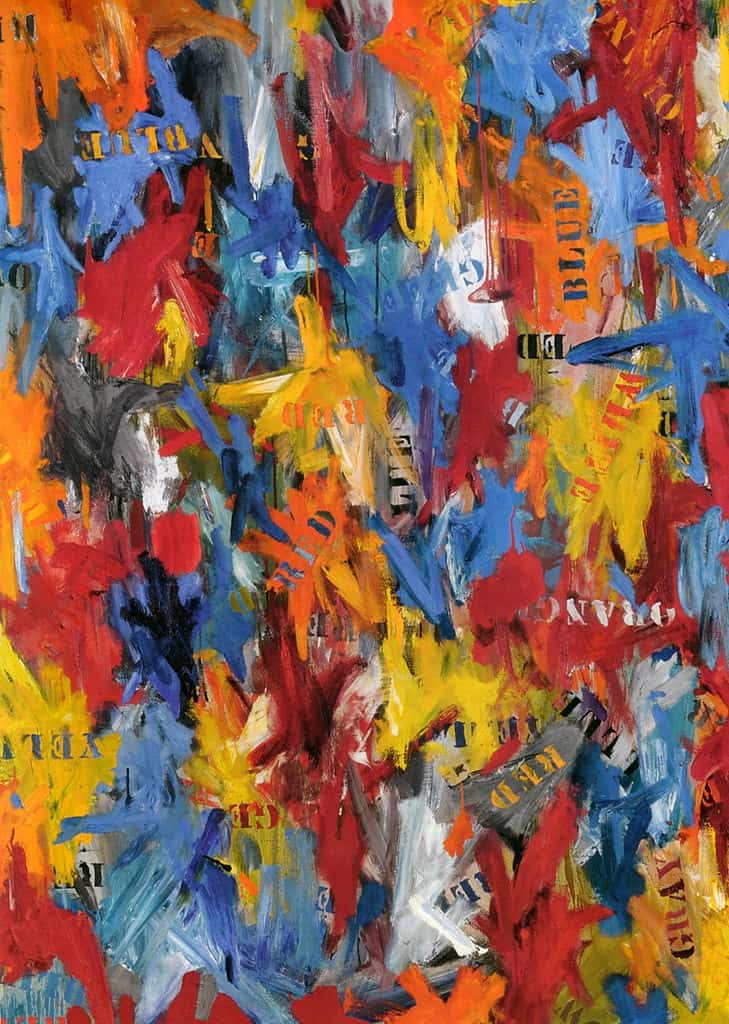
False Start is a powerful image that looks like it’s exploding in a firework show. An identifiable picture does not govern the composition; the brushstrokes are big, and the color is riotous.
The painting lacks the serene, dignified serenity of Johns’ early works, but it exudes nervousness and a sense of riskiness and insecurity. That False Start appears to be about color rather than using it as a medium is most striking.
Johns claims that the title of his work, “False Start,” was inspired by a racing graphic he spotted while drinking at the Cedar Tavern, a tavern frequented by artists in the period. An allusion to the artist’s mental state or emotions while creating was picked up on by many viewers and art aficionados.
Did You Know?
Jasper Johns is well recognized for rendering the American flag and other US-related subjects.
9. Orange, Red, Yellow
Artist: Mark Rothko
Year Created: 1961
Dimensions: 236.2 cm. × 206.4 cm.
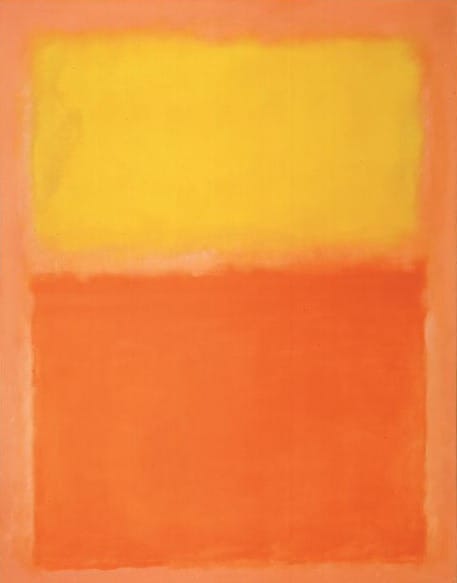
This vibrant work by Mark Rothko, who had been working in the Color Field genre for more than a decade by this point, contains hues of orange, red, and yellow. The rectangles in this picture don’t go all the way to the boundaries of the canvas; instead, they seem to float just above it. Chromatic afterimage has the effect of enhancing this impression.
Looking at each colored piece separately impacts how people perceive it. The yellow color above the red-orange core of the picture is somewhat green. The orange appears to have a blue hue due to the yellow above. Rothko wanted his works to be valued for more than only their spectral features, notwithstanding these color connections.
Did You Know?
At a Christie’s sale 42 years after his passing, Marc Rothko breaks records, and this, too, provides its own grounds to go down in history.
8. Dora Maar au Chat
Artist: Pablo Picasso
Year Created: 1941
Dimensions: 128.3 cm. x 95.3 cm.
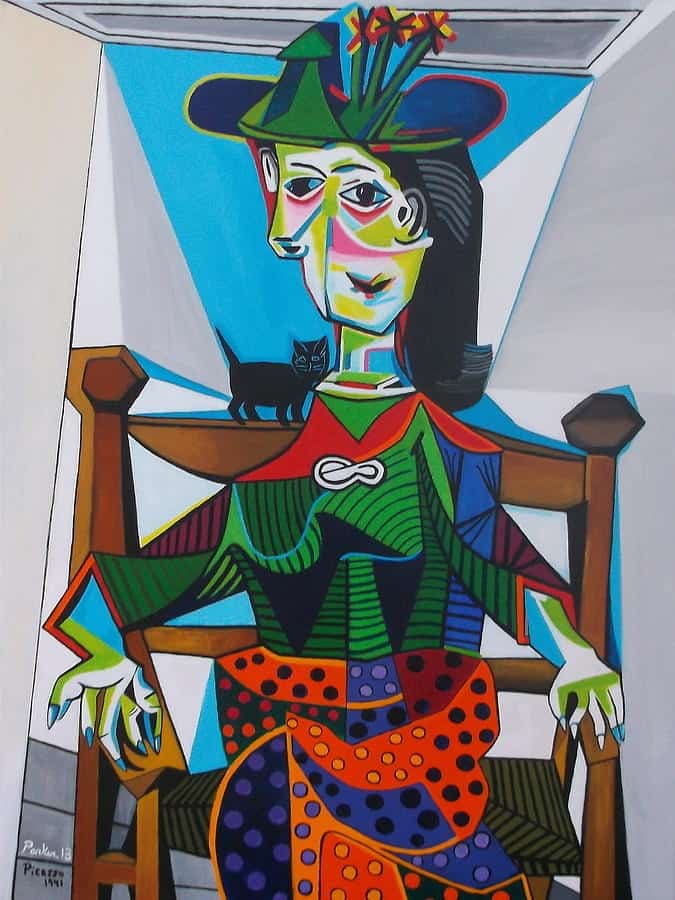
Pablo Picasso created the oil painting Dora Maar au Chat. It was painted in 1941 and featured the artist’s beloved Dora Maar, also known as Henriette Theodora Markovitch, sitting in a chair with a little cat perched on her shoulders. After selling for $95 million at Sotheby’s on May 3, 2006, the painting is now considered to be one of the most expensive works of art.
Pablo Picasso created several portraits of Dora Maar throughout the course of their close to a ten-year relationship, including the work in question.
When Maar was employed as a movie photographer on the set of Jean Renoir’s film Le Crime de Monsieur Lange, when Picasso first encountered her, their friendship was born.
Did You Know?
It is currently Picasso’s sixth most popular painting for sale.
7. Anna’s Light
Artist: Barnett Newman
Year Created: 1968
Dimensions: 275.3 cm. x 690.9 cm.
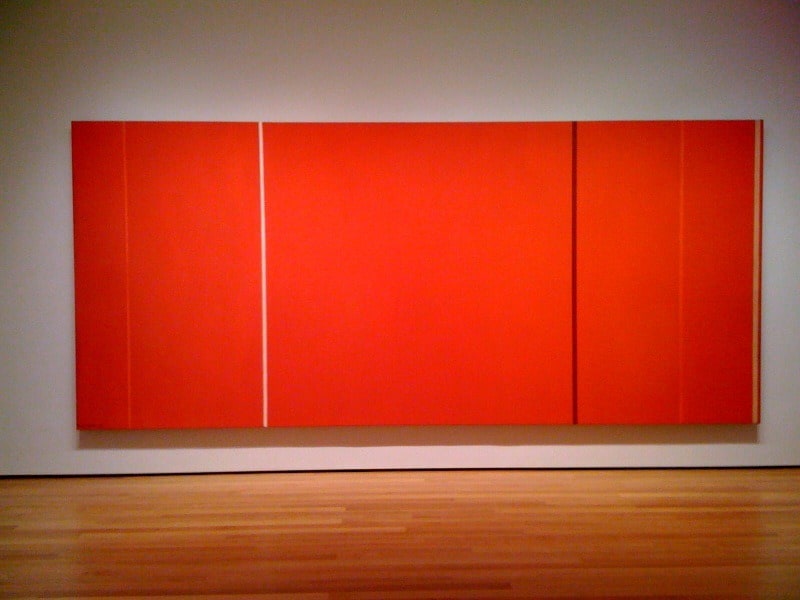
The biggest painting ever created by Newman (274.3 x 609.6 cm), Anna’s Light, is part of the Kawamura Memorial DIC Museum of Art collection. The observer can’t help but be intimidated by this canvas’s huge plane of cadmium red, which appears to tint the surrounding light in its color.
But many people also experience feelings of serene repose, hope, love, or frightful awe simultaneously.
The way that Newman worked was to embrace each canvas with an open mind and no preconceived notions of how the new piece should develop. And the title of the piece was chosen after it was finished as a representation of the emotions that surfaced during the artistic process.
Did You Know?
The artist’s mother, Anna, whose death occurred three years before the creation of the painting, is referenced in the title of this enormous red artwork.
6. Nude, Green Leaves and Bust
Artist: Pablo Picasso
Year Created: 1932
Dimensions: 162 cm. x 130 cm.
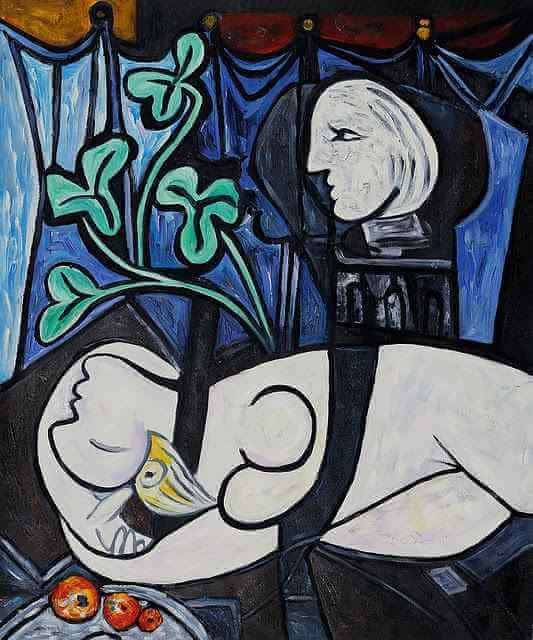
Apart from depicting the nature of Picasso’s love connection with Marie-Thérèse, Nude, Green Leaves, and Bust also examine the issue of feminine submissiveness. Out of his collection of huge nudes, it is without a doubt one of the most sensual paintings. In the picture, Marie-body Thérèse is depicted with a philodendron plant — a symbol of fertility — growing from her.
Picasso was influenced by ancient mythology. In 1929, he created a sculpture titled Woman in the Garden using philodendron leaves. Marie-Thérèse was shown in the sculpture as the goddess Daphne who had transformed into a shrub. This artwork makes use of the same motif.
Did You Know?
The picture has its own importance as a representation of sensuality and desire, even though it does not rank among the top 10 most recognized paintings worldwide — despite this, many people feel that it is one of Picasso’s finest works.
5. Woman III
Artist: Willem de Kooning
Year Created: 1953
Dimensions: 172.7 cm. ×123.2 cm.
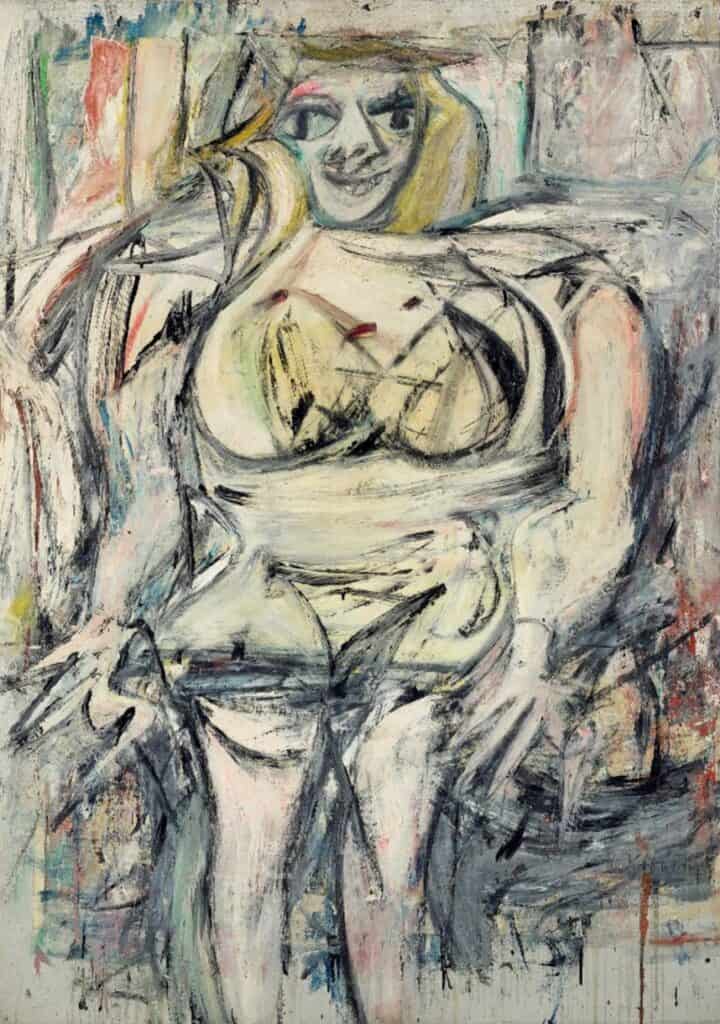
One of Willem de Kooning’s most recognizable and costly paintings is titled Woman III. It generated a great deal of controversy, much like all the early 1950s paintings from the Women series did. The public was perplexed and terrified by the artist’s tense and combative demeanor in addition to such, to put it gently, non-standard depictions of female nudeness.
Later, according to De Kooning’s dealer, he worked on this series particularly cruelly, at times even poking tiny holes in the canvas while frantically applying the strokes.
Any female representation in Western art differed vastly from De Kooning’s “ladies.” They were horrifyingly vocal and sexually aggressive. These ladies were too different from the Cold War-era stereotype of the meek American housewife.
Did You Know?
De Kooning purposefully abandoned this idealization and produced entirely new heroines who, despite being abstract, were much more realistic.
4. No. 5
Artist: Jackson Pollock
Year Created: 1948
Dimensions: 243.8 cm. x 121.9 cm.
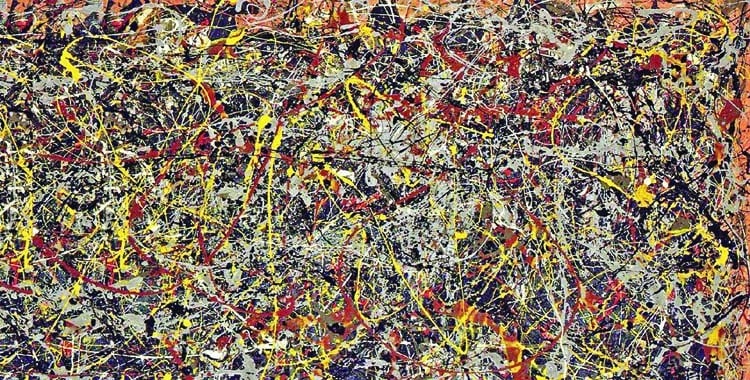
Jackson Pollock’s No. 5, 1948, a picture of chaos in the form of a bird’s nest and a masterwork of abstract expressionism, is among the most well-known works of American art from the 20th century. In his drip-era paintings, Pollock experimented with new ways to use color and line to convey emotion.
The drip paintings, which were controversial yet viewed as attractive, drew the attention of young art buyers who were seeking out the most cutting-edge items on the market.
Pollock demonstrated that the concept behind his painting was as significant as the work he exerted for it by defying conventional rules with his outrageous technique.
Like No. 5, 1948, all of Pollock’s works from the drip phase were made by placing a sheet of fiberboard on the ground to act as a canvas, providing the artist the largest number of angles and range of motion to splash, smear, spatter, drip, throw, and pour his paints into a picture.
Did You Know?
The angles and inferred movements in Pollock’s work exhibit mathematical accuracy, as researchers have interestingly demonstrated.
3. Le Reve
Artist: Pablo Picasso
Year Created: 1932
Dimensions: 130 cm. × 97 cm.
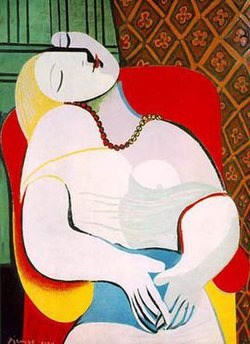
Pablo Picasso, who was 50 at the time, painted his mistress Marie-Thérèse Walter, then 24 years old, in the oil painting titled Le Rêve (The Dream in French), which measures 130 x 97 cm. On January 24, 1932, it was reported that it was painted in a single afternoon.
It comes from Picasso’s time of deformed representations, and the overly simple shapes and stark color contrasts are reminiscent of early Fauvism.
Critics have often called attention to the painting’s sensual undertones, pointing out that Picasso placed an erect penis in the model’s upturned face, apparently to represent his own. Victor and Sally Ganz of New York City acquired Le Rêve in 1941 for a cost of $7,000.
These five artists — Picasso, Jasper Johns, Robert Rauschenberg, Frank Stella, and Eva Hesse — have been the focus of their 50-year collection.
Did You Know?
Le Rêve was among the Ganzes’ collection that was auctioned off by Christie’s on November 11, 1997, after their deaths (Victor in 1987 and Sally in 1997).
2. Les Femmes d’Alger
Artist: Pablo Picasso
Year Created: 1955
Dimensions: 114 cm. × 146.4 cm.
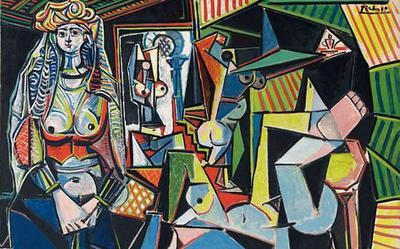
Pablo Picasso produced a collection of 15 paintings and several sketches titled Les Femmes d’Alger (Women of Algiers). The Women of Algiers in their Apartment by Eugène Delacroix, painted in 1834 (French: Femmes d’Alger dans leur appartement), served as the inspiration for the 1954–1955 series.
Picasso produced several series as homages to other painters he loved.
Picasso started experimenting freely with Delacroix’s The Women of Algiers in their Apartment (Les Femmes d’Alger) in December 1954. The “oriental” theme of this series of paintings has powerful connections with both Matisse and Delacroix for Picasso, who started his first version (cat. 19) six weeks after learning of the passing of his longtime friend and competitor Henri Matisse.
Did You Know?
Victor and Sally Ganz paid $212,500 (the equivalent of $2.1 million in 2021) for the full series of Les Femmes d’Alger in June 1956 from the Galerie Louise Leiris in Paris.
1. No. 6 (Violet, Green and Red)
Artist: Mark Rothko
Year Created: 1951
Dimensions: 75 x 44 cm
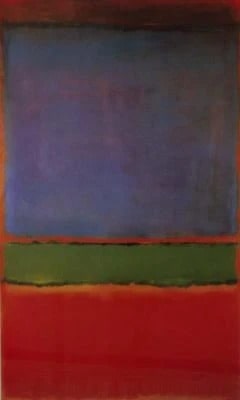
Considered to be the most expensive abstract painting ever sold, Mark Rothko, a Latvian-American abstract expressionist painter, created No. 6 (Violet, Green, and Red) in 1951. No. 6 features broad swaths of color separated by erratic, hazy tones, just like Rothko’s previous pieces from this era.
A very significant price for any artwork, $186 million, was paid for Mark Rothko’s No 6 (Violet, Green, and Red), which was auctioned in 2014.
At auction houses worldwide, several of Mark Rothko’s paintings continue to bring in record sums. These paintings are priceless because they demonstrate how important Mark Rothko is as an artist today. People often ponder why his straightforward paintings garner such high prices when they look at them.
Did You Know?
8 Most Expensive Paintings Ever Sold in History
Learn About the 11 Rarest Colors to Ever Exist
10 Rare Pigments Used Throughout History
8 Most Expensive Van Gogh Paintings Ever Sold
9 Most Expensive Bob Ross Paintings Ever Sold
8 Oldest Paintings in The World
7 Oldest Cave Paintings in The World
